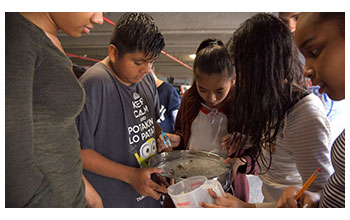Multimedia Gallery
Students participating in the Billion Oyster Project
Students participating in the Billion Oyster Project (BOP) examine organisms they pulled from New York Harbor. An initiative of New York Harbor Foundation, the National Science Foundation-supported BOP is an ecosystem restoration and education project aimed at restoring 1 billion live oysters to New York Harbor. The project engages school children through restoration-based STEM (Science, technology, engineering and mathematics) education programs.
More about this image
Research consistently shows that children who have opportunities to actively investigate natural settings and engage in problem-based learning greatly benefit from the experiences. They gain skills, interests, knowledge, aspirations and motivation to learn more. But how can educators provide these rich opportunities in densely populated urban areas where resources and access to natural areas are limited?
With support from the National Science Foundation (NSF), Pace University educator Lauren Birney and her team are getting middle school students involved in an ambitious restoration program called the "Billion Oyster Project." The students study New York Harbor and the extensive watershed that empties into it, and conduct field research in support of restoring native oyster habitats.
"This National Science Foundation grant has made the 'Curriculum and Community Enterprise for Restoration Science (CCERS) Project' possible, advancing environmental restoration through experiential and inquiry-based learning with New York City students and teachers involved at the core of the research," explains Birney, director of Pace University's STEM Collaboratory. "Pace University serves as the prime research institution leading a city-wide collaboration emphasizing the benefits of citizen science to underrepresented students in New York City. We are enormously grateful to the NSF for supporting this work and creating such outstanding digital imagery depicting the 'real work' of the project!"
This research involves a broad partnership of institutions and community resources, including Pace University, the New York City Department of Education, the Columbia University Lamont-Doherty Earth Observatory, the New York Academy of Sciences, the New York Harbor Foundation, the New York Aquarium, The River Project, Good Shepherd Services, University of Maryland's Center for Environmental Science, Smartstart Evaluation and Research, Gaylen Moore Program Evaluation Services, and others.
"This project is bringing hands-on restoration- and research-based learning that works so well in classrooms around the city. We've focused on neighborhood schools in poor and working-class areas, where this type of programming is rare and sorely needed. We are delighted with this opportunity to bring authentic science to the children of New York City," says Robert Newton, senior research scientist, Lamont-Doherty Earth Observatory.
This research was supported by a grant from NSF (grant DRL 14-40869), "Curriculum and Community Enterprise for New York Harbor Restoration in New York City Public Schools."
BOP was highlighted in an episode of NSF's "Science Nation" titled "Hands-on learning research that benefits the economy, environment". You can learn more about the program Here. (Date image taken: 2015-2016; date originally posted to NSF Multimedia Gallery: March 22, 2017)
Credit: Billion Oyster Project/CCERS
Images and other media in the National Science Foundation Multimedia Gallery are available for use in print and electronic material by NSF employees, members of the media, university staff, teachers and the general public. All media in the gallery are intended for personal, educational and nonprofit/non-commercial use only.
Images credited to the National Science Foundation, a federal agency, are in the public domain. The images were created by employees of the United States Government as part of their official duties or prepared by contractors as "works for hire" for NSF. You may freely use NSF-credited images and, at your discretion, credit NSF with a "Courtesy: National Science Foundation" notation.
Additional information about general usage can be found in Conditions.
Also Available:
Download the high-resolution JPG version of the image. (471.2 KB)
Use your mouse to right-click (Mac users may need to Ctrl-click) the link above and choose the option that will save the file or target to your computer.

 All images in this series
All images in this series